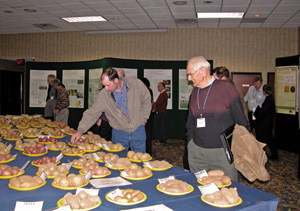
Features
Agronomy
Genetics/Traits
New developments in common scab research
Common scab is a global problem.
March 4, 2008 By Dr. Eugenia Banks*
Common scab caused by the bacterium Streptomyces scabies is a global problem. Thus, the International Common Scab Conference held in March 2007 in Ontario was an excellent opportunity to discuss this disease from a worldwide perspective. Thirteen speakers participated, some of them coming from as far away as Australia and South Africa. Approximately 155 people attended the conference and most of them were potato producers. The conference was sponsored by the Ontario Potato Board and organized by the Ontario Ministry of Agriculture, Food and Rural Affairs (OMAFRA).
There was a consensus among speakers, researchers and growers that the incidence and severity of common scab has been increasing steadily during the last decade. Four reasons were suggested to explain this:
1. Development of more aggressive strains of the common scab pathogen.
2. Increased acreage of susceptible cultivars.
3. Spread of the common scab pathogen in infected seed.
4. Poor soil conditions due mainly to short crop rotations and soil compaction.
 |
| There is inconsistency in control methods used against common scab. |
The control practices recommended for scab were discussed at the conference and, again, there was a consensus among participants that nearly all of the recommended management practices provide erratic results. Dr. Gary Secor from North Dakota State University summed it up. “The only thing that is consistent with common scab control is the inconsistency of the control methods.” This statement does sound familiar to all potato producers.
Stable genetic resistance was considered to be the most reliable control method. In scab-infested fields, only cultivars with stable resistance should be planted. Unfortunately, resistant varieties are not available for all markets and all growing areas. Potato breeding programs around the world are now putting emphasis on selecting clones with resistance to scab in the early stages of the breeding process.
Dr. Doug Rouse from the University of Wisconsin gave a presentation on the use of the fumigant chloropicrin (Pic-Plus) to control common scab. The results of his row fumigation trial conducted in 2005 indicated that chloropicrin significantly reduced the incidence and severity of common scab when used at 80 and 100 pounds per acre. Parallel on-farm trials gave similar results.
Dr. Leslie Wanner, a plant pathologist with USDA at Beltsville, provided information on new developments on common scab research, not only at the International Common Scab Conference but also at the National Potato Council Seed Seminar held in Missouri on December 7 and 8, 2007. The following is a summary of some of the topics she discussed at the meetings.
 |
| Ontario potato growers, Nelson Parker (left) from Union and Harry VanDerZaag (right) from Alliston, look at a variety display during the International Common Scab Conference. |
A survey of pathogenic Streptomyces in 19 states in the US and in New Brunswick identified four species among more than 700 pathogenic strains. In almost all cases, only a single species was found in a field location, although different species were frequently found in near-by locations. The most common species found was S. scabies, the first described and best known common scab pathogen.
Wanner indicated that there is genetic variation in Streptomyces strains from all over North America and it looks like different strains are characteristic of different geographic regions. Some strains cause more severe symptoms than others, but the severity is also affected by the amount of pathogen present in the soil and the stage at which the pathogen infects the developing tuber. It is not yet clear if there are differences in the susceptibility of different potato varieties to different strains. It may be possible in the future to plant a variety usually thought susceptible to scab because the strain of scab in the field is not very aggressive.
Wanner addressed two important questions often asked by growers: How much of a pathogenic species is found in the soil at different times throughout the growing season? What does this indicate about the risk of a serious common scab problem?
She has developed a molecular technique to estimate the amount of pathogenic bacteria in soil and on the surface of tubers. Using this technique, she found that the same large amounts of pathogen are present in soil around developing tubers that end up with severe common scab and in those that show no symptoms. It seems that some regulatory factor in the bacteria must control pathogenicity, and it is not simply a function of the number of pathogenic bacteria present. Wanner is currently investigating the mechanism of this regulation, as this obviously would provide the knowledge base to formulate new strategies for controlling common scab disease.
Molecular techniques are very sensitive and Wanner can detect low numbers of pathogenic Streptomyces in nearly all soil samples, nearly all of the time. The same is true for potato tuber skins; both pathogenic and non-pathogenic Streptomyces can be found. The numbers of pathogens are much higher in and around developing potato tubers and in common scab lesions. She has laboratory data showing that the scab pathogen can multiply very quickly (as much as 100,000 times in about a week) under favorable circumstances, such as those that presumably occur on a newly developing tuber. This means that the potential for a common scab problem is nearly always present, and it also means that a large number of pathogenic bacteria are introduced by planting scabby potatoes.
Wanner indicated that mature tubers do not develop common scab. This suggests that potato plants make something that inhibits pathogenicity. Finding out what this is may lead to better ways to control common scab. By researching the different aspects of the host, pathogen and environment interaction, it may be possible to suggest more reliable control methods some day. -end-
*Dr. Eugenia Banks is a potato specialist with Ontario Ministry of Agriculture, Food and Rural Affairs in Guelph.